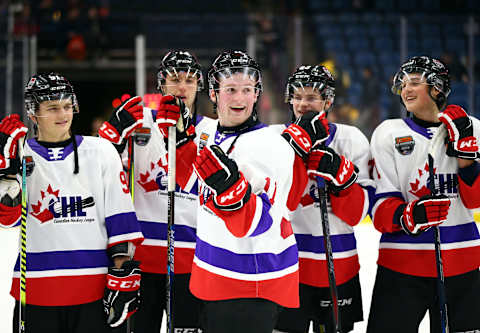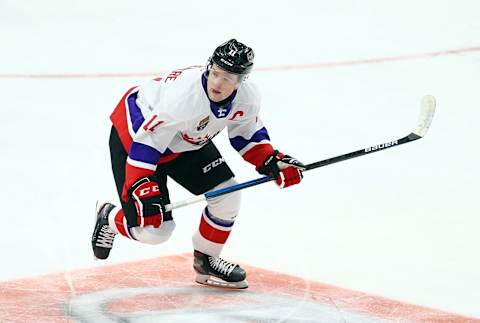New York Rangers: How does Alexis Lafrenière compare to previous 1st overall picks?


Alexis Lafrenière is a surefire star, but how does the future New York Rangers winger compare to previous first overall picks?
New York Rangers fans are still brimming with excitement after winning the first overall pick in the draft, and with it, the opportunity to draft a special talent in Alexis Lafrenière. There is simply no disputing that Lafrenière is Canada’s best draft prospect since Connor McDavid, who was a generational forward prospect. That said, let’s just rip off the bandaid right away: despite his generational hockey IQ, Lafrenière is not a Connor McDavid or a Sidney Crosby level prospect. He falls somewhere below those two players.
In this piece, we take a look at how Lafrenière compares to previous prospects that ended up going first overall in order to begin setting the expectations for Rangers fans. I did this using two analytics tools, NHLe and Game Score Value Added (GSVA), both of which will be explained on the next slide. I then used Lafrenière’s comparables to show how we should expect Lafrenière to perform in his first season as a New York Ranger. Let’s dive in!

What is NHLe? What is Game Score Value added, or GSVA?
NHLe, or NHL equivalency, is a statistical model that translates points in other leagues to NHL points using historical data. The NHLe model I am using was created by Byron Bader, who has a website called Hockey Prospecting (subscription required) . As an example of how the data is used, let’s take a look at Alexis Lafrenière. Lafrenière’s 112 point QMJHL season translates to 46 points over a full NHL season. As a sidenote, Byron’s tool also gives examples of other players with the most similar statistical profiles. Lafrenière’s closest comparables are Steven Stamkos, Nikita Kucherov, Alex DeBrincat, Mitch Marner, and Vincent Damphousse.
Game Score Value Added, or GSVA, is an all-in-one statistic created by Dom Luscyszyn of The Athletic (subscription required). The formula for this model assigns values of varying importance to different statistics, such as goals, primary assists, secondary assists, and so on. What I love about this statistic is that it is a middle-ground for people who enjoy macro-analytics but also think that results-driven statistics matter, such as goals and assists. In other words, if you are an excellent possession player but cannot finish or provide assists, you don’t get a free pass because ultimately the point of hockey is to score goals.
GSVA scores themselves are fairly simple to understand, so here are the different score tiers with a Rangers player who scores in each tier.
- 3.75 or greater: A legitimate Hart Trophy candidate. Think Artemi Panarin
- 3.0 to 3.75: An Elite player. Think Mika Zibanejad
- 2.0 to 2.99: A top-line forward or top-pairing defenseman. Think Adam Fox
- 1.0 to 1.99: A top-six forward or top-four defenseman. Think Chris Kreider
- .5 to .99: Middle-six forward or borderline second-pairing defenseman. Think Jesper Fast
- .01-.49: Bottom-line forward or bottom-pairing defenseman. Think Brendan Lemieux
- 0: Replacement forward or defenseman. Think Julien Gauthier.
- Below 0: Detrimental to the team, AHL level player. Think Brett Howden.
Whatever score a player has, all you have to do is double the number to find out the impact that player has on a team’s success. For example, if Mika Zibanejad posted a GSVA of 3.0, then that means his contributions win his team six standings points each season. If Brett Howden posts a GSVA of -.5, that means his contributions cost his team 1 standing point each season.

Who are some of Lafrenière’s NHLe comparables?
Now that we have established what NHLe is, let’s take a look at how Lafrenière’s draft season compares to previous first overall picks going back to Patrick Kane in 2007. We will also throw in Jack Eichel since he would have gone first overall in all but three of these drafts.
2019: Jack Hughes, 50 NHLe points*
*Take this one with a massive pinch of salt. There is no reliable translation data of USHL points to NHL points since Hughes is the first to trek that path. Perhaps the model used Hughes’ totals against NCAA competition, but that was a VERY small sample size.
2018: Rasmus Dahlin, 31 NHLe points
2017: Nico Hischier, 32 NHLe points
2016: Auston Matthews, 66 NHLe points
2015: Connor McDavid, 63 NHLe points, Jack Eichel, 55 NHLe points
2014: Aaron Ekblad, 22 NHLe points
2013: Nathan MacKinnon, 36 NHLe points
2012: Nail Yakupov, 40 NHLe points
2011: Ryan Nugent-Hopkins, 38 NHLe points
2010: Taylor Hall, 46 NHLe points
2009: Steven Stamkos, 42 NHLe points
2008: John Tavares, 46 NHLe points
2007: Patrick Kane, 62 NHLe points
It is clear that four prospects here are clearly a cut above the rest: Patrick Kane, Connor McDavid, Auston Matthews, and then half a step below is Jack Eichel. If you have an NHLe of 60 or above, to me that means that you are a generational prospect. Then you move on to the Lafrenière tier. MacKinnon was days away from being eligible for the 2014 draft, so let’s bump him up. Hall, Tavares, MacKinnon, Stamkos, and Lafrenière make up the next tier. We won’t compare Lafrenière to Dahlin, but he should be included in that tier as well.
Hughes may have an NHLe of 50, but I do not trust that number because it is clearly based on his NCAA sample, which I mentioned is quite small. Let’s put Hughes on his own in the next tier below the one I just mentioned. Then below Hughes, you have the Nugent-Hopkins, Yakupov, Hischier tier. Ekblad sits at the bottom of the barrel.
So just to clarify, here are our numbered tiers:
McDavid, Matthews, Kane, Eichel
Lafrenière, Tavares, Stamkos, Hall, MacKinnon, Dahlin
Hughes
Nugent-Hopkins, Yakupov, Hischier
Ekblad

How did Lafrenière’s closest comparables do in their first NHL seasons? What was their Game Score Value Added?
We have now established that Lafrenière’s closest forward comparables are Taylor Hall, Nathan MacKinnon, Steven Stamkos, and John Tavares. All four players are superstars and between them, they share a Hart Trophy (possibly two with how well MacKinnon has played), a Rocket Richard Trophy, numerous international Gold medals, and each player has worn a letter on their jersey. These players have all competed for scoring titles, and that is what I think the future holds for Lafrenière. But how did their rookie seasons go?
Stamkos, as many of us know, had a rocky start to his professional career, and Glen Sather claims he had a handshake agreement on a trade that would have brought Stamkos to New York during his rookie season. Stamkos put up 46 points in 79 games, which was a bit underwhelming but a good start to his career. Beyond the simple box stats, Stamkos contributed a GSVA of 0.72, which puts his rookie contributions at good middle-six value.
John Tavares is next in line and he had a strong rookie season, contributing 56 points in 82 games for a weak Islanders team. Just as his point totals indicate, Tavares provided solid second-line value for the Islanders, posting a GSVA of 1.17. Next up is Taylor Hall, who went first overall to the Oilers in 2010 and won the Hart trophy during the 2017-18 season. Hall had a decent rookie season, posting 42 points in 65 games for the tanking Oilers. His GSVA in his rookie season was 1.01, indicating he provided second-line value to the Oilers lineup.
Last but not least we have Nathan MacKinnon. I included MacKinnon in this group because even though his NHLe is lower than the rest, he was also a much younger prospect than the other players listed here and was arguably the most anticipated. He is now a front-runner for the Hart Trophy and a perennial contender for the scoring title. MacKinnon had an excellent rookie season on a middling Avalanche team, posting 63 points in 82 games. He posted a GSVA of 2.14 in his rookie season, which is first-line value and by far the best of this group of players.

So what can New York Rangers fans realistically expect out of Lafrenière in his rookie season?
The hardest part of this comparison is predicting the role that Lafrenière will play on the Rangers. If he was a right-winger he would step into the top-six immediately, but he joins a very strong left-wing unit. My guess is that Quinn will only be able to keep him there for so long, but that’s just conjecture at this point. Some have argued that this strong competition may limit his rookie year production. Conversely, Lafrenière coming into a playoff-contending team is an excellent situation for him and may result in much better results since he will have more support than the other players in his tier did during their rookie seasons.
For the sake of the argument though, let’s assume Lafrenière earns himself a top-six role early on in the season. The easiest way to predict what Lafrenière’s impact will be is as simple as taking the averages of the data we have here. Let’s start with the projection of the points using points per game (ppg).
Steven Stamkos: 46 points in 79 games = .58 ppg
John Tavares: 56 points in 82 games = .68 ppg
Taylor Hall: 42 points in 65 games = .65 ppg
Nathan MacKinnon: 63 points in 82 games = .77 ppg
That results in a points per game average of .67, which translates to 55 points over an 82 game season. Next, let’s do the same method using GSVA. For this example, we will also use Rasmus Dahlin because GSVA levels the playing field for defensemen.
Steven Stamkos: .72 GSVA
John Tavares: 1.17 GSVA
Taylor Hall: 1.01 GSVA
Nathan MacKinnon: 2.14 GSVA
Rasmus Dahlin: 1.54 GSVA
The average GSVA of those five players is 1.32, which is a very strong second-line value and lines up pretty much perfectly with the predicted surface level production of 55 points in 82 games. I honestly think that is a very realistic prediction for Lafrenière’s rookie season. While he is not McDavid, he is an amazing prospect, and Rangers fans have every right to be excited about him and the impact he will make on the rebuild.
light. Related Story. Do the Rangers have the patience?